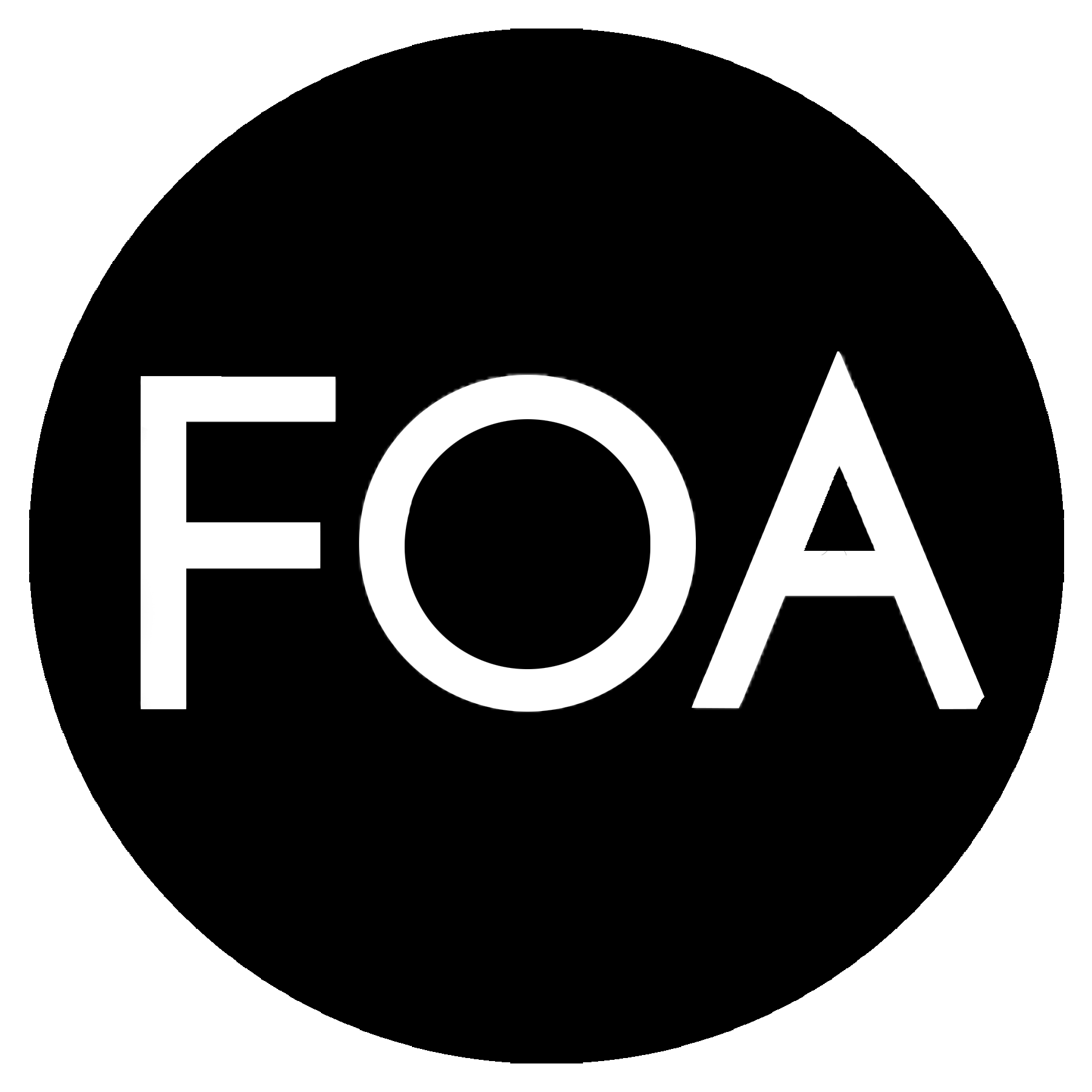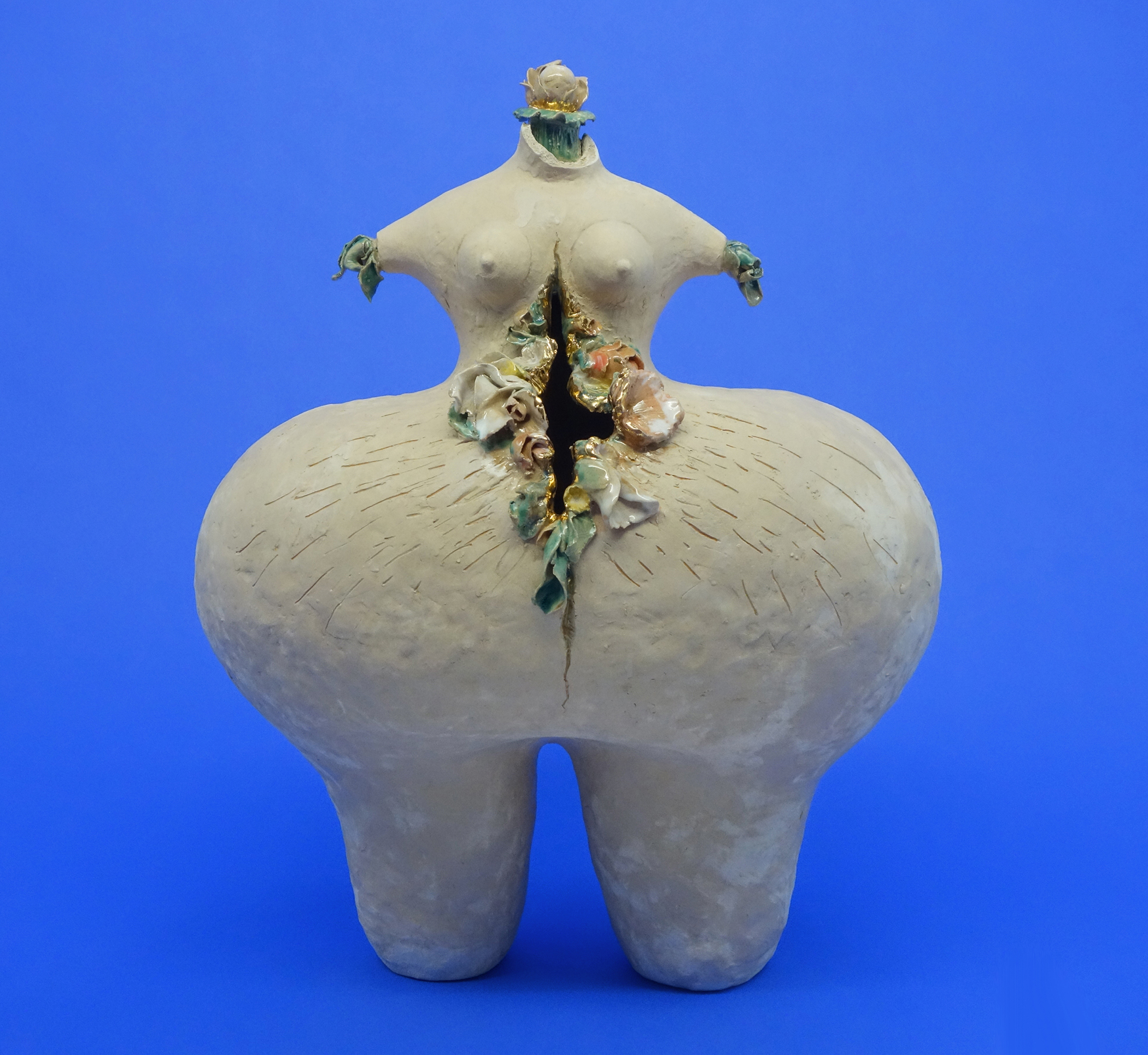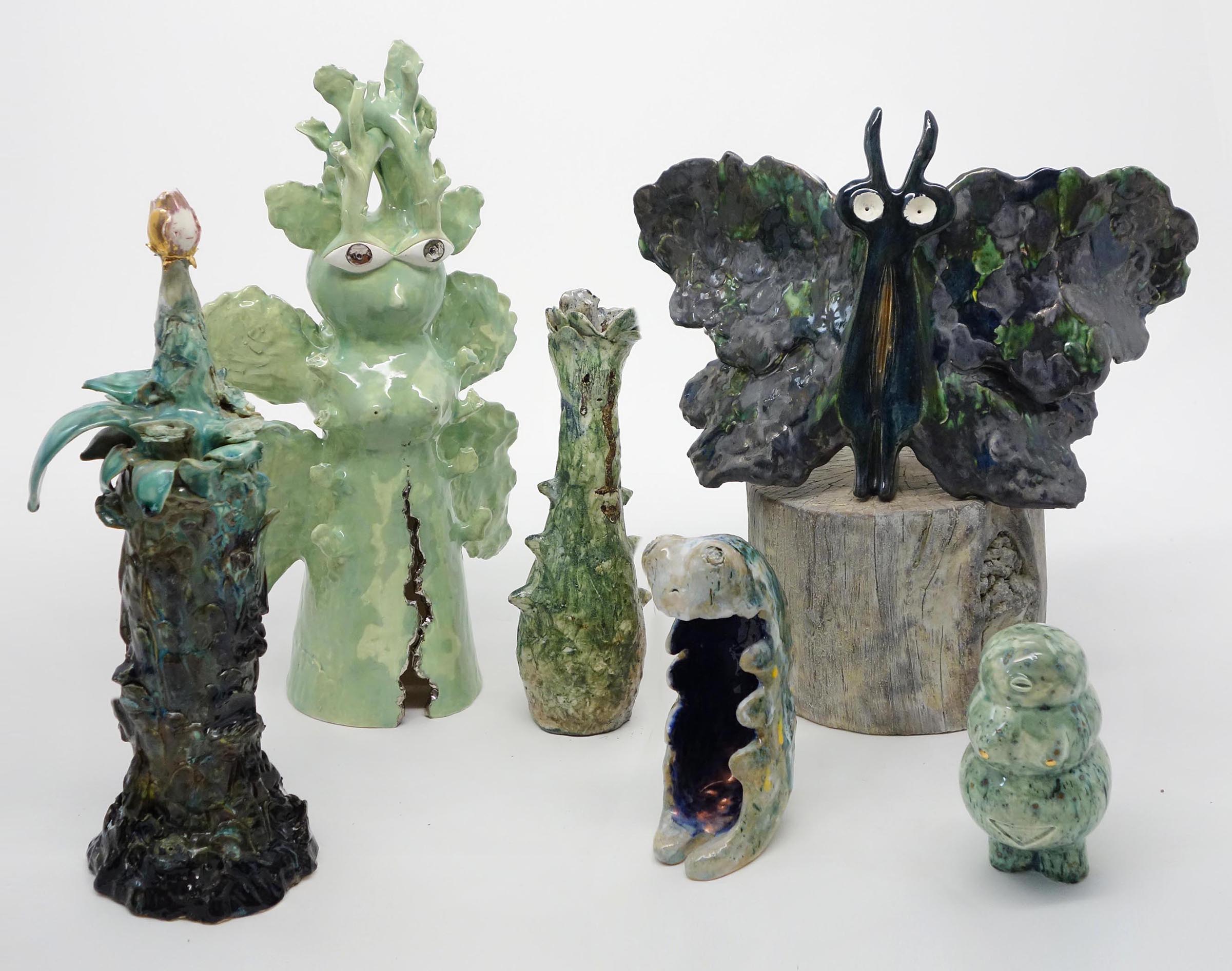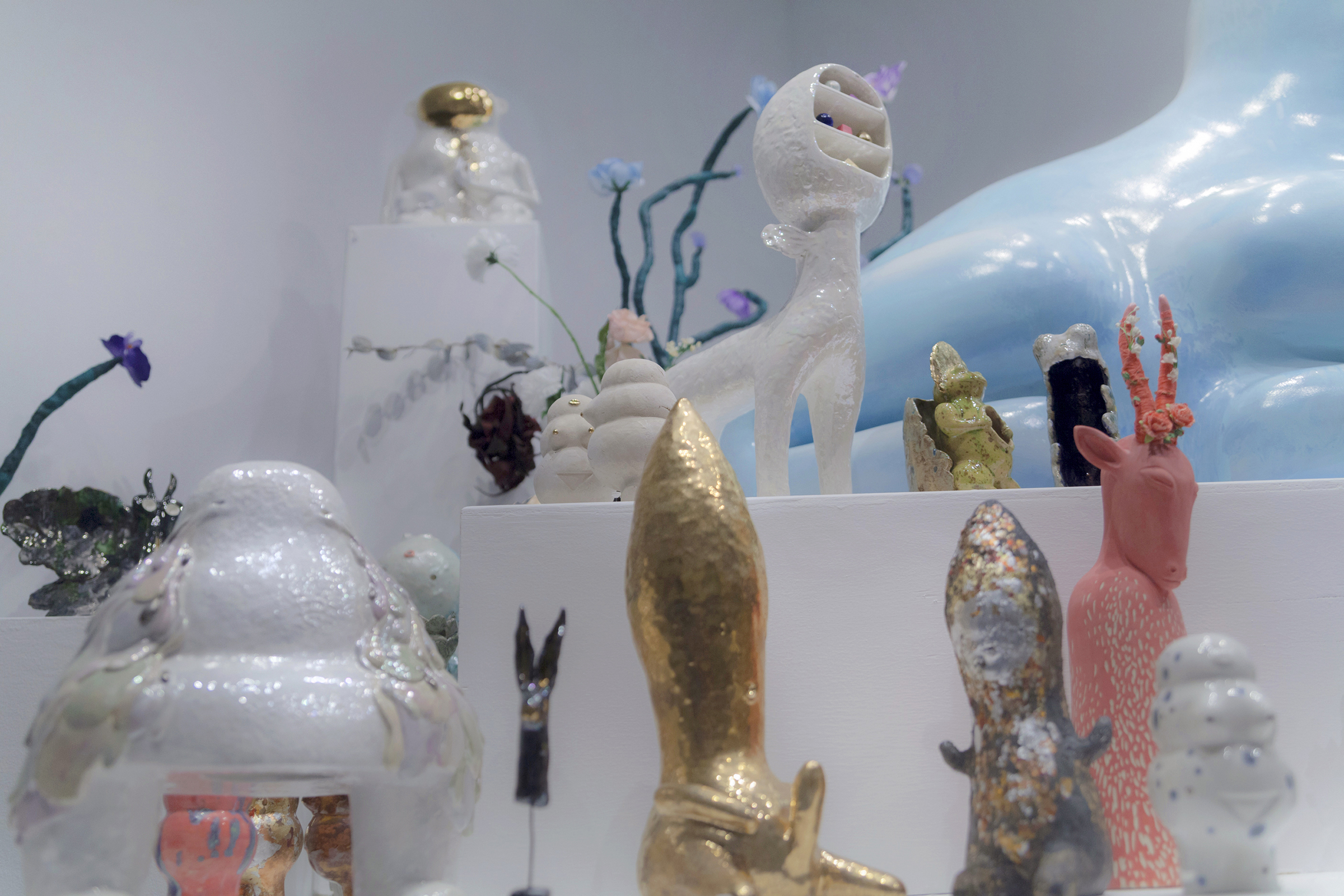Interview with Shamona Stokes: “Horn of Plenty”
Interview with Shamona Stokes: “Horn of Plenty” at Fort Worth Community Art Center
Shamona Stokes is a ceramic sculptor from Jersey City, NJ, and holds a BFA from Pratt Institute in Brooklyn, NY. Her iconic sculptures explore the archetypes and imaginary figures of the subconscious mind. In September 2019, her show "Horn of Plenty" was on view at the Fort Worth Arts Center. This installation featured a 7 foot tall fiberglass unicorn-sphinx entitled "Antenna" that was surrounded by a family of approximately 50 smaller ceramic figures.
In this interview, she speaks to Anna Mikaela Ekstrand about the show, her upbringing, and the future of her artistic practice. Anna Mikaela Ekstrand is the founder of cultbytes.com, an online art publication, artists management, and PR agency.
Written by Anna Mikaela Ekstrand
To create “Antenna” and realize “Horn of Plenty” you crowd-sourced the funds on Kickstarter. Why did you choose Kickstarter and what opportunities did using the platform open?
I decided to use Kickstarter on a whim! When I was given the opportunity to do an installation in Texas I had about 35 smaller works but felt that something large was needed to be the centerpiece of a shrine idea that I’d been thinking about. I got some campaign pointers from a friend who used to work at Kickstarter and created a video with the help of my husband. I never used to be this way but the “post-explosion” version of me just throws herself into things. It was an aggressive push to generate 15k in only 3 weeks and it took a huge effort. In the end, I was happy and relieved when it was successfully funded. With the funds I was able to collaborate with Nick Kirk to upscale the unicorn sculpture that I named “Antenna.” The horn represents tapping into higher realms of creativity and the ability to fix a broken imagination.
‘Horn of Plenty’ features fifty ceramic sculptures. Are they hand-built? What type of glazes have you used? Please tell us about how they are crafted!
All the works were a labor of love built during the last 3 years. With the exception of the small fertility statues, which were created from a mold, everything else was built by hand using a pinching technique. I start by working from the ground up and pinch the clay as I build up the form, so essentially each piece is hollow. Sometimes I get so immersed in molding the clay that I work with my eyes closed–it can be very relaxing!
After the pieces are dried, I do a bisque firing to harden them, a second firing to apply the various glazes, and then oftentimes will do a third firing using special metallic luster and mother-of-pearl glazes that give the pieces their magical finishes. From start to completion it can take about 6 weeks to see the final outcome since there are so many stages. This is the only part of the process that can be frustrating for me…not having that immediate gratification.
When did you start working with clay?
I started working with clay in 2015. I was freelancing at a design agency in the city when my co-worker suggested we both take a class together at SVA to do something different with our hands. Our teacher showed us the basics of hand-building & mold-making but then gave us creative carte blanche to make whatever we wanted. We were given 24-hour access to the ceramic facilities so I took complete advantage of that and ended up taking this class 3 times just to have access to the studio.
Cool! You mentioned you “post-explosion” self earlier – I love that term. You had a creative block that you overcame through meditation practice. How did this come about?
After childhood, I was always very stuck creatively. When I was in art school I was a good renderer and won the awards at school for “best whatever” but I was too concerned with things looking perfect. My work felt contrived and lacked spontaneity. After I graduated, I ended up pursuing graphic design for many years and only did a creative project for myself maybe once a year at best. I was really sad that I’d left my love of art by the wayside and had repressed my desire to create for so long. When I started going inwards with meditation, it all exploded to the surface.
I first saw the Venus of Willendorf” at Documenta 13 in 2012 and was spellbound. Can you tell us about how you first came across this ancient fertility sculpture and how you came to incorporate it into your work.
I loosely remember the Venus of Willendorf from my college art history class. I never really thought about it but it must have left a subconscious impression on me… Flash forward to 2016 and we’d just gotten our first dog, Roi, during the same time that I began learning ceramics. Roi had a dog toy that we would put treats in and it was a form made of 3 rounded lumps. I picked it up and thought, “if I just stick some breasts and legs on this, it would look just like a female body.” And that was that, it was just the spark of a seemingly silly idea that I gave legs to.
Why were you drawn to figures representing fertility and what are some of the archetypes for your other figures?
I didn’t think much of it at the time, but making these fertility statues spoke to something much more deep-rooted that was taking place inside of me. It was a symbolic representation of creative rebirth; something playful-looking at face value but much more meaningful if you were to dig deeper. I’d always been a tomboy: disliked dresses, flowery things, and I loved loud and aggressive. I was also never the one who wanted to have children of my own (although I love kids); there was just this hyper-feminine aspect that was not present within me. When I began going inwards some kind of deep shift happened and all this creativity burst forth. I wasn’t literally giving birth to a baby, but I was having a re-birth of my own imagination.
In addition to the Mother archetype my sculptures also explore the shadow, the orphan, the sage, and the magical child.
That’s dense. Now I’m curious about your childhood. You grew up in New Jersey with parents from India. Does being multi-cultural effect your work?
My parents aren’t together anymore, but growing up with Eastern ancestry has and is still having a continuous affect on my work. My mom is from a Portuguese colony in India (Goa) and my dad is from a small village in the foothills of the Himalayas called Kotgarh. They were essentially from two different worlds and managed to meet in New Jersey of all places.
Sadly, my heritage was something that I repressed due to racism experienced during my childhood. At that time (in the 80s-90s), there wasn’t much positive Indian representation in the media; I felt like I had no role models. As a result, I didn’t want to be different and having parents from an exotic land was difficult. I just wanted to blend in and be like everyone else but ended up feeling like I didn’t belong anywhere most of the time. In limbo. It was only post-high school that I really started to embrace my roots.
I’ve now been to India four times and my longest trip was 3.5 months. This was one of the most important things that I’d ever done in my life. I was able to immerse myself in my ancestral culture: the food, the temples & shrines, seeing beautiful art like the painted miniatures up close. Anyone who’s ever been to India can tell you that it will test you and it taught me how to let go and embrace the uncertainty and chaos of life. These influences all flow into what I’m creating now–even if it’s not evident at first glance in every piece.
We first met at SuperFine! Art Fair you were in the booth next to an artist I was working with, Meir Srebriansky. You have also done SCOPE. What are the pros and cons about participating in art fairs as an artist?
In the two years that I’ve been showing work as an independent artist, I’ve done four art fairs, a handful of group shows, and this last installation in Texas. At art fairs, I’ve had the serendipitous luck of being placed next to artists who I’ve had a lot in common with. I would’ve never shown at SCOPE had it not been for a group of Superfine! artists that had seen my work the year prior. When one of the artists in their collective couldn’t participate in the show, they asked me to join them. I didn’t hesitate and we all drove down to Miami together. On the long drive down we were blown away by all of the things we had in common. It seemed like the universe was playing art match-maker! The only downside that I’ve experienced is that the fairs can be pretty physically draining. All the driving, the installs, the being on your feet all day. It takes thick skin. Additionally, the booth fees can be expensive so it helps to have other artists to split the costs with.
You studied at Pratt but decided to pursue other work after graduating. Now, several years later you have returned to your art practice and you are being showed and showing extensively – congratulations! How do you approach working as an artist differently now, as opposed to then?
Thank you! When I was in college I mostly drew realistically and was inspired by the precision of the old masters. But when I moved into my major, which was illustration, we were forced to create a recognizable style. At the time, I was influenced by street art and the stylized characters of graffiti artists like Barry McGee. I would create these very layered compositions of people that included spray paint, layers of drawing and scribbles, and wheat pasted elements. Once dried, I would then take sandpaper and scratch away the layers to reveal buried elements.
My work today looks nothing at all like my work back then but the thread that connects everything is a visual rawness. Even though my sculptures may seem cute at first glance, there’s always an element of grittiness that I’m trying to get across. I’m drawn to broken things, scratches, wabi-sabi-ness.
Where would you like the art world to take you in the next couple years?
As fun as it’s been to roll up my sleeves and create my own opportunities, it’s been equally tiring. I’m looking forward to doing more collaborations with other artists. I’d also like to move out of my home studio (right now I work 80% from home, 20% at a studio in Hoboken) to a full-time studio that’s in more of a community space. I feel like my best work is generated when I’m around other like-minded artists; where we can take short breaks to exchange ideas. It helps to breakup the seclusion that goes along with this lifestyle.
I hear you! Social interactions spur me as well. What other projects do you have coming up?
I’m going to learn something new! The director at Sculpture Space NYC in LIC has asked me to participate in a program where they’ll be teaching me the software to create sculptures using 3D ceramic printing. I’m excited to see what kinds of weirdness will emerge.
Can’t wait to see how this evolves! Thanks so much. How can our readers stay in touch.
Thank you for including me in the FOA family! Visit my website shamonastokes.com or follow me on Instagram @SHAMSTOKED.






